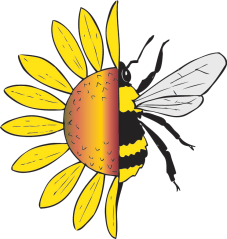Field Guide to Native Bees
Bees belong to an order of insects called “hymenoptera” meaning “membrane wings”. This order includes wasps, ants and sawflies. Look closely and you will see bees and wasps have four transparent wings. Bees also have two mouthparts: mandibles for chewing and a long tongue for drinking nectar. The single most distinguishing feature that sets bees apart even from wasps is that bees are fuzzy! This feature makes them the perfect pollinators. The hairy bodies are great for collecting protein-rich pollen that is then stored in “pollen baskets” on the hind leg or some other pollen-carrying mechanism. Pollen is the primary food source that bees provision their developing brood.
Bees live various lifestyles from solitary bees, where every single female bee is an egg layer to social bees where only the queen lays eggs. 70% of solitary bees lay their eggs in underground brood chambers (ex. mining bees), while 30% of bees lay their eggs in existing holes in trees, brambles or other vegetation (ex. mason bees and leaf cutter bees). Some even drill their own nesting hole (large carpenter bee). Bumble bees are one of the few native and more familiar social bees in North America.
In North America there are 4,000 species of bees that are divided into six categories (Families). The diversity of bees is overwhelming but yet, whether a specialist or generalist, these eclectic groups of pollinators are extremely efficient at what they do. Native bees evolved with native flowers and have the know-how to pollinate more efficiently than non-native bees such as the revered honey bee.
The following is a field guide to common native bees and wasps found in our backyards. They usually go about their business of pollination unnoticed. But if you learn about them and understand something about their habits and appearance, this spring they may magically appear to you!
Download a Garden Guide to Native Bees of the Hudson Valley.
garden-guide-native-bees-to-the-hudson-valley


